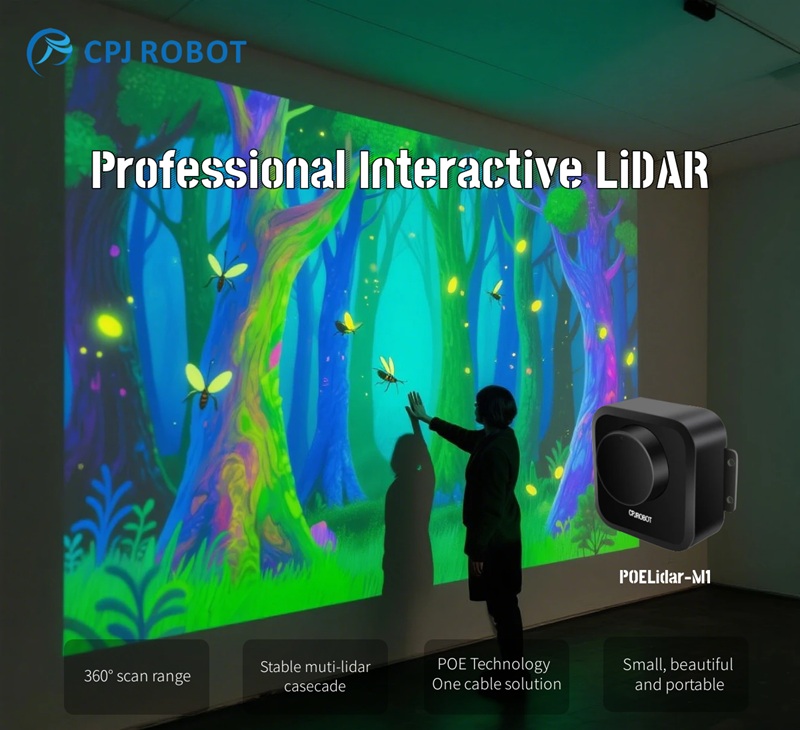Introduction: The Future of Interactive Displays
As technology continues to evolve, interactive display systems are transforming how people engage with digital content. From large-screen interactive installations to LiDAR-powered projection walls, these systems merge motion tracking, laser sensing, and real-time projection to create fully immersive experiences.
Whether in a museum, shopping mall, restaurant, or exhibition hall, interactive walls bring digital art, games, and brand stories to life — allowing users to interact naturally through gestures, body movement, or even simple proximity.

What Is Large-Screen Interaction?
Definition and Working Principle
Large-screen interaction refers to a digital display system that uses LiDAR, infrared, or motion sensors to capture user actions and translate them into real-time responses on the screen. Unlike traditional touchscreens, users can interact without physically touching the surface.
Through advanced sensor fusion and image processing, the system detects the position, speed, and gesture of multiple users simultaneously — enabling dynamic activities such as drawing, gaming, or collaborative interaction.
Key Features
- Multi-user interaction: Supports several participants at once
- Multi-touch and gesture recognition: Responds to complex actions like swiping, tapping, and dragging
- Immersive content display: Works with projectors, LED walls, or LCD screens
- Touch-free control: Eliminates the need for physical input devices
These capabilities make large-screen interaction ideal for brand activations, digital exhibitions, corporate presentations, and educational installations.
LiDAR Projection Wall Interaction
How It Works
In a LiDAR-based projection wall system, a projector displays visual content on any vertical surface — such as walls, panels, or glass — while LiDAR sensors track motion within the interactive area.
When users move their hands or bodies, LiDAR waves capture precise depth and position data. The system processes this information to trigger responses like particle animations, floating text, or real-time games.
Advantages
- Immersive visual effects: Create themed environments like ocean worlds, galaxies, or futuristic cities
- Real-time responsiveness: Ultra-low latency for natural interactions
- Flexible installation: Suitable for walls, floors, and curved or irregular surfaces
- Engaging content: Perfect for entertainment, exhibitions, and digital art shows
With POE (Power over Ethernet) LiDAR technology from CPJ ROBOT, users can enjoy a plug-and-play installation experience, simplified wiring, and high-precision motion capture.
LiDAR Interactive Wall: Beyond Traditional Touch
Technology Overview
Radar interactive walls rely on laser radar (LiDAR) or millimeter-wave radar to scan and detect movements within a defined area. The radar system continuously maps the environment, identifying motion trajectories with millimeter accuracy.
Main Benefits
- Non-contact interaction: Perfect for hygiene-sensitive environments
- Multi-point recognition: Tracks multiple touchpoints simultaneously
- Adaptable to any surface: Works on glass, painted walls, or even water
- Cross-platform integration: Compatible with engines like Unity, Unreal, or TouchDesigner for creative development
This makes radar-based interactive walls ideal for public spaces, art installations, and immersive retail experiences, where creative engagement and safety both matter.
Applications Across Industries
1. Exhibition and Museum Displays
Transform static exhibits into interactive storytelling experiences where visitors can explore digital content through movement and gesture.
2. Hospitality and Entertainment Venues
In bars, restaurants, or hotels, interactive walls create a fun, futuristic atmosphere that enhances customer engagement.
3. Corporate Events and Showrooms
Businesses can use LiDAR interactive displays for dynamic presentations, product showcases, and brand storytelling.
4. Education and Training
Interactive projection systems make learning more engaging through gamified content and real-time feedback.
Why Choose CPJ ROBOT’s POE LiDAR Solutions
CPJ ROBOT specializes in developing POE LiDAR sensors and intelligent reception robots, offering integrated solutions for interactive displays and smart environments.
Key Advantages
- Free testing software for rapid setup and calibration
- High-precision LiDAR sensing for accurate multi-point tracking
- Custom development services to meet unique project requirements
- Professional support from a trusted LiDAR manufacturer
From small-scale museum installations to large immersive projection halls, CPJ ROBOT provides reliable, adaptable, and affordable LiDAR technology for creative applications.
Frequently Asked Questions (FAQ)
Q1: What is the difference between infrared and LiDAR interactive systems?
Infrared systems detect motion based on light reflection, while LiDAR measures precise distance using laser pulses, allowing for higher accuracy and better performance in complex lighting conditions.
Q2: Can LiDAR projection walls support multiple users at once?
Yes. Advanced LiDAR systems can detect and process multiple users’ movements simultaneously, making them ideal for group interaction and entertainment.
Q3: Is it difficult to install a LiDAR projection wall?
Not at all. With CPJ ROBOT’s POE LiDAR, installation is simple — just connect the sensor via Ethernet, calibrate using the free software, and start interacting.
Q4: What kind of content can be displayed?
The system supports animations, videos, games, and real-time 3D content developed in engines like Unity or Unreal.
Q5: Where can these systems be used?
They are widely used in museums, exhibitions, hotels, malls, restaurants, theme parks, and corporate lobbies.
Conclusion: The Next Level of Digital Interaction
Large-screen interaction, LiDAR projection walls, and radar-based interactive systems represent the future of digital engagement — blending technology, art, and human experience.
By using CPJ ROBOT’s POE LiDAR technology, you can create immersive, touch-free interactive walls that captivate audiences and enhance brand presence across any space.
Ready to make your walls come alive?
✨ Contact CPJ ROBOT today to explore custom LiDAR interactive display solutions for your exhibition, brand space, or entertainment venue.
Visit CPJ ROBOT Official Website to request a demo or learn more about our POE LiDAR and reception robot systems.







